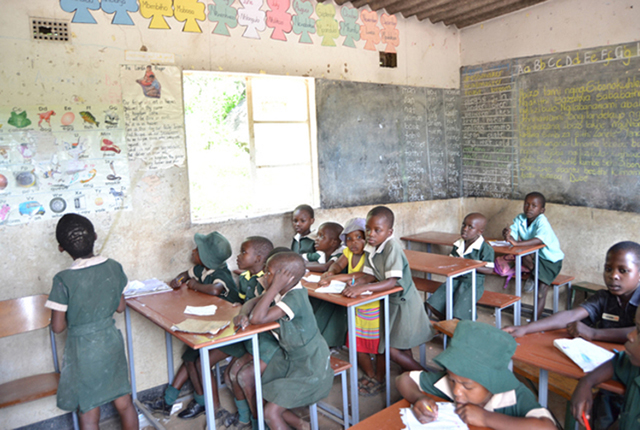Language skills revealed in new curriculum


Language learning under the new curriculum is made up of three categories namely indigenous, English and foreign languages
Stanely Mushava Features Correspondent—
Language skills in infant school are set to gain on the introduction of full colour, high octane, modern, vastly entertaining, culturally grounded and civically relevant textbook series based on the new curriculum.Two of the foremost academic publishers, Consultus Publishing Services and College Press have pioneered the publishing of language textbooks that are suited to the demands of the freshly incepted curriculum.
College Press was first on target with the Readers are Leaders series for English language instruction in infant school, while CPS, formerly Longman Zimbabwe, recently published textbooks in eight indigenous languages.
CPS’s language-straddling feat is informed by the diversity focus of the Zimbabwe Constitution and the Curriculum Framework for Primary and Secondary Education.
It includes Rava ChiShona, Ziva ChiShona and Bala IsiNdebele for the instruction of Shona and Ndebele in infant and junior school, and an Early Childhood Development (ECD) reading series in eight indigenous languages.
“All our books have been written to the new curriculum, ensuring that the content addresses teachers and learners needs, and objectives, according to each subject syllabus,” CPS operations director Masimba Tinashe Madondo told the education segment of The Herald Review.
“The CPS/Ziva ChiShona series has a variety of features that are new to local language textbooks. This includes the use of full colour illustrations and photographs that are relevant to Zimbabwe, and help to demonstrate cross-cutting issues,” he said.
Language in the new curriculum now focuses on verbal competency but accommodates cross-cutting themes, namely gender, children’s rights, disaster risk management, financial literacy, sexuality, HIV and AIDS, child protection, heritage studies, human rights, collaboration and environmental issues.
CPS has a mouth-watering initiative whereby, in addition to traditional distribution channels, its titles will be accessible in digital format on CPS Online Store (cps.co.zw) for compatible smartphones and computers beginning next month.
This marks a first by a Zimbabwean publisher, general or academic. Previously, the overwhelming majority maintained a Luddite approach to business, with only directory entries on second-party websites to account for their online presence.
Increased accessibility in this respect can help shut out piracy, a perennial millstone on Zimbabwe publishers’ backs.
The Ministry of Primary and Secondary Education bought a substantial percentage of the initial stock for free distribution in schools across the country.
The ministry’s right hand of fellowship, extended to all publishers, is critical for financially empowering publishers to create content for the new curriculum.
And there is a second first.
The glossy covers come with an anti-piracy feature that is a first in the Zimbabwe textbook publishing industry, produced by Directory Publishers, a Bulawayo-based printer.
“The technique called reverse spot UV varnish creates a finish that cannot be reproduced by photocopying. This help teachers, parents and law enforcement agents to distinguish between genuine and counterfeit books,” Madondo said.
CPS’s new sequence, edited by Sophia Gwakuka, has Shona titles such as “Upenyu Kuzvichengetedza,” “Mukunda waMambo neDzimwe Nyaya,” “Vana neDafi” and “Mufaro naRunako” under Rava ChiShona series, “Gwaro reKutanga” to “Gwaro reChitatu” under Ziva ChiShona and Ndebele titles such as “Impilo kaGugu eDolobheni,” “Imuli kaGugu,” “Vakatsha loGugu” and Kholisa loGugu” under the Bala IsiNdebele series.
“CPS/Ziva ChiShona Books 1a, 1b are accompanied by the CPS|Rava ChiShona Books 1–10 controlled readers, and CPS Bumbiro Remavara alphabet flashcards, for development of reading and writing skills. CPS Rava ChiShona Nhanho 1 is a great way for Grade 3 learners to add on to on what they learn from CPS Ziva ChiShona Book 3,” Madondo said.
The Readers are Leaders series by College Press, previously reviewed in another section is a 22-book set coordinated by veteran children’s writer Jenny Yon. It includes the titles, “Our Families,” “Kudzai Learns His Rights,” “Sara at School,” “The Girl with No Phone” and “At the Farm”.
Language learning under the new curriculum is made up of three categories namely indigenous, English and foreign languages.
All the officially recognised languages of Zimbabwe, Chewa, Chibarwe, English, Kalanga, Koisan, Nambya, Ndau, Ndebele, Shangani, Shona, sign language, Sotho, Tonga, Tswana, Venda and Xhosa, are being progressively uploaded into the school system, cutting away from the old order where everything revolved around Ndebele, Shona and English.
The Zimbabwe Constitution directs state institutions at every level to ensure equitable treatment of official languages, take people’s language preferences into account, promote, advance and create enabling conditions for the development of those languages.
Primary and Secondary Education Minister Dr Lazarus Dokora said there was a shift from emphasis on content to emphasis on critical skills under the new curriculum. Language learning has been configured to suit this new dispensation.
“Historically, the Zimbabwean education system like others around the world, emphasised the importance of strong content knowledge at the expense of critical skills and competencies,” Dr Dokora said.
“There is, however, increasing recognition that content mastery is not adequate as an exit attribute. The emphasis is now on achieving higher-order thinking skills and competencies,” he said.
Setting forth new objectives in the curriculum framework, the ministry commends activities like drama and storytelling for the development of verbal and non-verbal communication, auditory and visual discrimination and memory.
At infant level, learners are equipped with animation reading, book and pre-writing skills. The mother tongue is used as the medium of instruction with media such as radio, television and computer programmes deployed to encourage linguistic competency.
“At the junior school level, indigenous languages remain important as avenues for fostering early literacy. The introduction of a second language and its alternate use with the indigenous language in the learning environment helps learners master concepts and achieve linguistic competency for learning and communicative purposes,” reads the curriculum framework.
“The learning of English and its use as language plays a vital role in the development of literacy in that it enhances learning in other areas of the curriculum. A foreign language creates opportunities for the learner to interact with an otherwise closed world.
“Both English and any foreign languages play complementary roles. They help learners to develop communication skills and critical understanding that are necessary for meaningful and active participation in society and the world at large,” says the framework.
On the whole, the new curriculum looks to build up a patriotic, disciplined, holistically oriented, peaceable, harmonious, multi-skilled, innovative, independent, civically alert and environmentally aware citizen. Language learning is being grafted into the ministry’s toolkit to this end.
Feedback: [email protected]










Comments